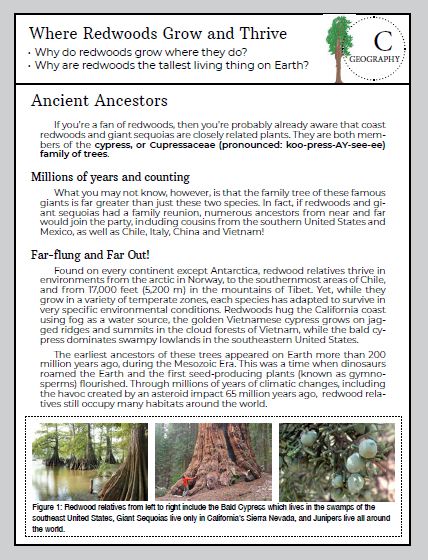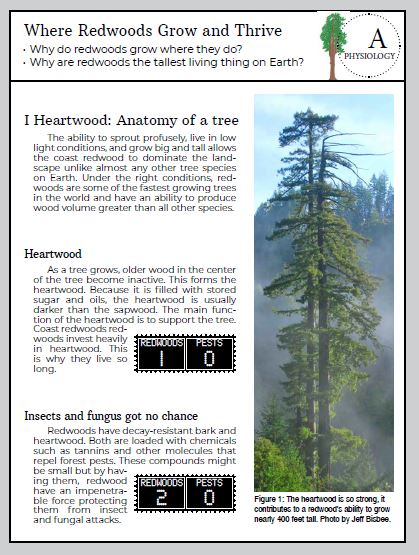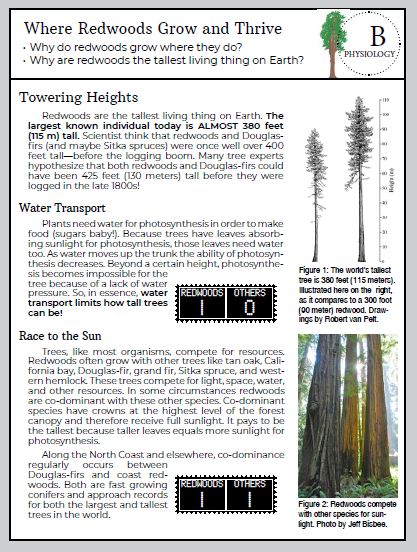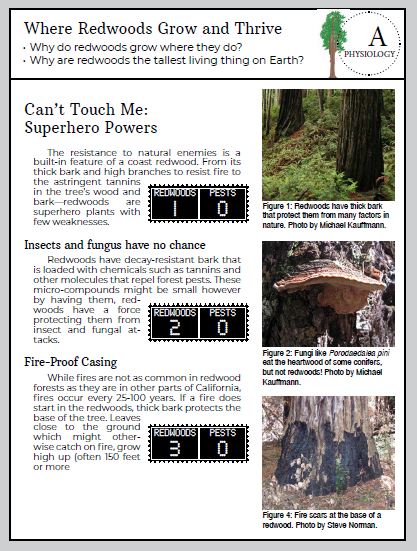Becoming the world’s tallest trees
Place-based Middle School Curriculum
Key questions students will answer:
- Why do redwoods grow where they do?
- Why are redwoods the tallest living things on Earth?
Elements of the lesson to consider:
- Teachers: READ THIS FIRST
- Activity is designed for 6th-8th grade but could be used in High School.
- Students should be assigned one of the pages to read and then research further. Pages are organized by reading level. A is for emerging readers, B for grade level readers, and C for advanced readers.
- Upon reading the page, students should use a graphic organizer to distill the information (Day 1).
- This should be followed by a day of their own research in which they document sources and add to the graphic organizer (Day 2). Download the Graphic Organizer.
- Once students are able to answer the key questions with facts they have learned about redwoods, they should take that information and organize it into a presentation. Three ideas for this follow:

Redwoods and the California Current
Reading level B

Redwoods and the Temperate Rainforest
Reading level B

Redwood Ancestors
Reading level C

Redwood Forest Soil
Reading level B

Redwood Heartwood
Reading level A

Redwoods Get Tall
Reading level B

Redwood Forest Pests
Reading level A

Redwood Roots
Reading level A
NGSS Standards Addressed
Middle School
- MS-LS1-5 Construct a scientific explanation based on evidence for how environmental and genetic factors influence the growth of organisms.
- MS-LS2-1. Analyze and interpret data to provide evidence for the effects of resource availability on organisms and populations of organisms in an ecosystem. [Clarification Statement: Emphasis is on cause and effect relationships between resources and growth of individual organisms and the numbers of organisms in ecosystems during periods of abundant and scarce resources.]
- MS-LS2-2. Construct an explanation that predicts patterns of interactions among organisms across multiple ecosystems. [Clarification Statement: Emphasis is on predicting consistent patterns of interactions in different ecosystems in terms of the relationships among and between organisms and abiotic components of ecosystems. Examples of types of interactions could include competitive, predatory, and mutually beneficial.]
- MS-LS2-4. Construct an argument supported by empirical evidence that changes to physical or biological components of an ecosystem affect populations. [Clarification Statement: Emphasis is on recognizing patterns in data and making warranted inferences about changes in populations, and on evaluating empirical evidence supporting arguments about changes to ecosystems.]
- MS-LS2-5.Evaluate competing design solutions for maintaining biodiversity and ecosystem services.* [Clarification Statement: Examples of ecosystem services could include water purification, nutrient recycling, and prevention of soil erosion. Examples of design solution constraints could include scientific, economic, and social considerations.]

